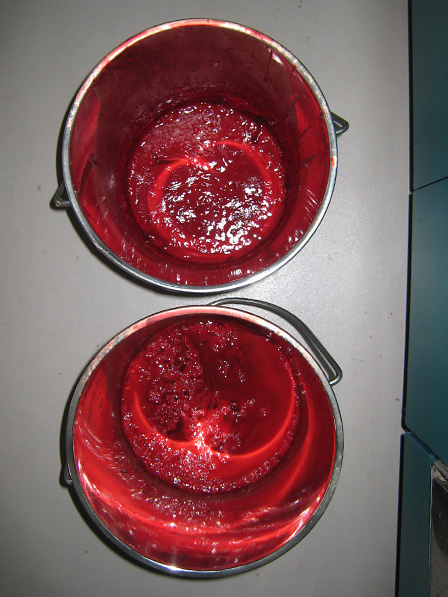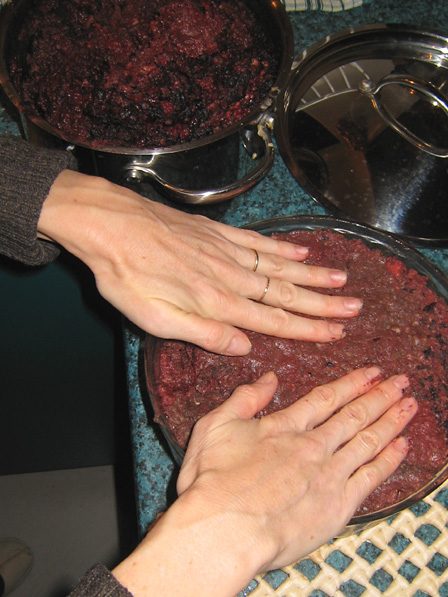“Once we accept the premise that living takes life, we can begin doing vitally important work: ensuring that farm animals and wild animals have the opportunity to lead a good life and die a good death. We need to approach the body of a slaughtered animal more holistically, ecologically, consciously and spiritually. We have to witness the lives and deaths of farm animals, and to be less squeamish about the truth of what happens to them.”
—Jessica Prentice, Full Moon Feast (An excerpt from the “Blood Moon” chapter of Full Moon Feast is available online)
The Winter Solstice is approaching. The first frosts have finally come, and the grass has all but stopped growing on the Farmlet pastures. Even here in the mild climes of Northland, the colder, darker days increase our hunger for rich meaty dinners and healthy grass-fed fat. Now is the time to kill some of the animals who have fattened on the sweet summer grass, to reduce the number of animals on the farm during the leaner winter months. The butcher and slaughterman are busy. We might call this season the “Blood Moon.”
Rosie’s calf, Herman Beefsteak, was the first of our livestock to be born and die on the Farmlet. His slaughter has marked a milestone for us, in terms of producing our own food. We feel proud to have raised a healthy animal who lived his short life outdoors enjoying his mother’s milk, fresh pasture and sunlight. We feel proud to have produced nourishing meat to feed ourselves and our loved ones. I also feel humbled by the enormity of taking this life in order to sustain our own lives. I can’t say I felt sad when I saw the steer’s body buckle from the slaughterman’s bullet; we have been resigned to the necessity of his early slaughter since before he was born. What I do feel is a profound responsibility to make the best possible use of this animal’s meat. More than ever, I want this food to be cooked with love and pride, and shared joyfully with family, friends and neighbours. More than ever, I feel the urge to hone my cooking skills to make the most thorough and nourishing use of this precious food.
As I contemplated the impending slaughter of our first steer, I resolved to take this opportunity to learn a new skill: How to make black pudding (sometimes called blood pudding).
Why?
* Because I had read about the great nutritional value of bovine blood fed on summer grass. In particular, it is a rich source of vitamin D.
* Because it seemed like a good way to reduce waste and make best use of the gift of this animal’s body.
* Because black pudding is delicious. (This is true. If you have not been brave enough to try it yet, you might be surprised to find out what a treat you have been missing!)
* Because, perhaps, this was my way of bearing active “witness [to] the lives and deaths of farm animals, and [being] less squeamish about the truth of what happens to them.” My part in the death of this animal was not to fire the bullet or skin the carcass, but I measured the still-warm blood into the saucepan. . . hurrying before it could congeal. The blood splashed my hands, and dribbled on the floor and kitchen cabinets: Mess. . . bathos. . . benediction?
So. . . how does a novice black pudding-maker make black pudding? I found this excellent recipe online, and have written my version (with a few small changes from the original) below.
Black Pudding for Beginners
2 litres fresh pork (or bovine) blood
3 onions, very finely chopped
5 cloves garlic, peeled and crushed
1kg suet or diced pork fat (back fat or bacon fat)
500ml heavy cream
500g rolled oats (soak them overnight in enough water to make a thick paste)
500g barley (soak it overnight and boil it in water for 30 minutes)
3 teaspoons salt
1 tablespoon ground coriander
2 teaspoons cayenne pepper
1/2 teaspoon ground nutmeg
Method:
Once you get the blood, you’ll need to use it quickly before it congeals, so do all the following in advance:
* Soak rolled oats overnight (use “quick oats” or finely rolled oats rather than the chunky “jumbo oats” for a smoother texture)
* Soak barley overnight in water with a little whey or lemon juice in it
* Boil and drain the barley
* Dice the pork fat, chop the onions and peel the garlic
* Check that you have the following gear handy: a very large, heavy-bottomed saucepan, a sturdy wooden spoon for stirring, clean buckets for catching the blood
* You will need a bain marie for cooking the pudding. If you don’t have a purpose-built bain marie, organise one in advance. (I figured out that I could make a water bath inside our large covered roasting pan, and then place a big pyrex casserole dish in it.)
Right before you get the blood:
* Preheat your oven to 160 degrees celcius.
* In a very large saucepan, soften the onions in 1/4 of the fat. Add the garlic and the rest of the fat, and leave to sweat slowly for 10 minutes.
* Add oatmeal and cream, and cook for a few minutes
* Add barley and spices and stir thoroughly.
Ideally, you have just reached this stage when your accomplice passes a bucket of fresh blood through the kitchen door!!
* Add the blood to the mixture as soon as you can after the kill. Cook mixture gently, stirring thoroughly until it has started to thicken like a dark, meaty porridge (maybe about 5 minutes).
* Bake in an ovenproof container using a bain marie for 1-2 hours until firm to the touch.
Once the black pudding is out of the oven:
* Turn it out of the cooking container while still warm.
* Once it cools, you can cut it into slices for storage
* Store in the fridge of freezer.
* Fry or bake slices of the pudding when you are ready to eat them.
 Buckets of blood
Buckets of blood
 Almost ready for the oven
Almost ready for the oven
 Finished
Finished
Questions:
How much blood do you get from one steer? I asked Lloyd (the slaughterman) this question. He said that he’d expect to get a good 10 litres of blood. . . but couldn’t be sure of catching more than half of it. So, I was very impressed when Kevin showed up in the kitchen with 10 litres of clean blood in our stainless steel buckets.
How quickly does the blood congeal? This probably depends on all kinds of variables, but we found that it set into a lump within about 10 minutes — and it started to congeal a good deal before that. I’d heard that stirring it and adding salt could help stop it setting, but Lloyd said he’d seen someone try these tricks and the blood still set like a rock in no time flat. I decided that the best course of action was to work quickly. I guess I got the blood into the saucepan within 5 minutes of the kill.
How much black pudding does this recipe make? About 4 or 5 kilos. I doubled the recipe and ended up with close to 10 kilos. That’s a lot of black pudding!
Did any difficulties arise during the cooking process? Since I doubled the recipe, the biggest challenge was dealing with the huge quantities of mixture. I could barely fit it all in my two biggest saucepans. Also, because of the small size of the bain marie I’d constructed, I had to bake it in four separate batches. (Then there’s the bit where the cook has blood splashed all over her hands, black pudding mixture sticking to the bottom of the pots for lack of stirring, and her baby needing some urgent attention. . . )
Does it matter if you can’t transfer the pudding to the oven as soon as the mixture starts to set? No, I don’t think so. I cooked four separate batches, one of which even had to be refrigerated overnight before it went in the oven. They all seem to have turned out fine.
Can you use a slow cooker instead of an oven to cook the pudding? I set up a water bath in our slow cooker, and tried cooking one batch in there. It worked out ok, but I think the resulting black pudding is a bit too soft and moist in texture. It tastes fine, but tends to fall apart in the frying pan.
Why didn’t you put the black pudding into sausage casings like lots of the recipes suggest? Because it’s a lot simpler and easier just to bake the pudding in a bain marie!
So. . . how did the black pudding turn out? Delicious! Such a treat for our winter breakfasts! I’m definitely planning to make black pudding again next time we kill an animal.







